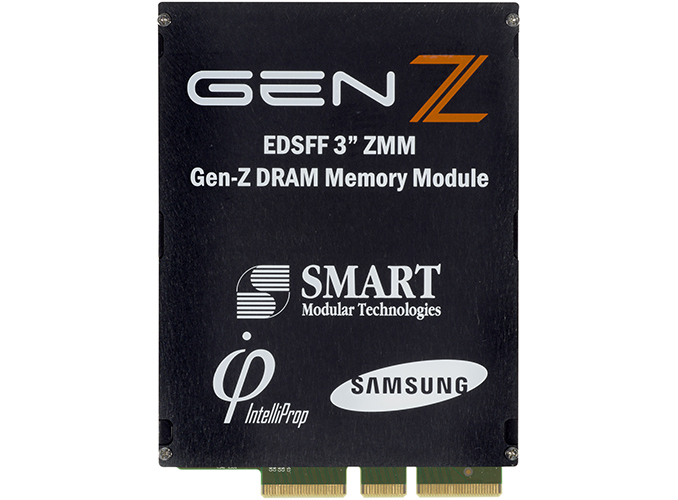SMART Modular Shows Off 256 GB Gen-Z Memory Module
by Anton Shilov on August 15, 2019 1:00 PM EST- Posted in
- Memory
- Samsung
- DDR4
- Gen-Z
- EDSFF
- Smart Modular
- IntelliProp

SMART Modular this month demonstrated one of the industry’s first prototypes of a EDSFF 3-inch DDR4 Gen-Z memory module. The ZMM supports advanced functionality enabled by the new interface and offers throughput akin to that offered by today’s DDR4-4000 memory modules.
SMART Modular’s 256 GB ZMM uses Samsung’s 32 Gb 4-high DDR4 DRAM devices as well as IntelliProp’s Gen-Z Mamba memory controller ASSP, which supports multiple access semantics, including byte and block addressable DRAM access, in-band configuration, and access key/region key memory isolation opcodes in a bid to simplify memory access needed to handle emerging data-centric workloads. The controller features 16 Gen-Z lanes with 25 Gbps PHY as well as 400 Gbps aggregate performance. The chip requires up to 20 W of power, so it needs proper cooling.
The Gen-Z module from SMART Module comes in SNIA’s 3-inch 4C SFF-TA-1008/9 form-factor, and offers a 30 GB/s bandwidth along with 400 ns deterministic access latency.
The 256 GB ZMM was demonstrated in rack servers designed by Dell and Hewlett Packard Enterprise specifically to test Gen-Z interconnection.
The showcase of a 256 GB Gen-Z ZMM by a well-known supplier of memory and storage solutions with two makers of servers indicates that the industry is getting ready for a roll-out of Gen-Z products in the future. What remains to be seen is when exactly SMART Modular and its partners will be ready with commercial Gen-Z modules and platforms.
Related Reading:
- Gen-Z Interconnect Core Specification 1.0 Published
- Hot Chips 31 (2019) Programme Announced: Zen, Navi, POWER, Lakefield, Gen-Z, Turing, Lisa Su Keynote
- Gen-Z Consortium Formed: Developing a New Memory Interconnect
- SMART Modular Announces 32 GB SO-DIMMs for Extreme Environments
- SMART Modular HRS-T5E: A Ruggedized SATA SSD with AES-XTS 256
Source: SMART Modular










15 Comments
View All Comments
boeush - Thursday, August 15, 2019 - link
Bandwidth-wise: the way I read it:- the _controller_ supports up to 400 Gbps total bandwidth
- the _specific configuration_ for this particular device (using that controller) offers 30 GB/s
In other words, the controller is capable of more performance, in theory - but isn't being maxed out in this specific design.
QChronoD - Friday, August 16, 2019 - link
30GB/s = 320Gbps, 80% of the 400Gbps of the controller.Vatharian - Saturday, August 17, 2019 - link
30GB/s = 240 Gb/s, or you know something I don't.ats - Thursday, August 15, 2019 - link
Because it is in effect being accessed across a ethernet interface. And once you add in the required switches, it will easily be over 1000ns, fyi.name99 - Friday, August 16, 2019 - link
So this is basically competition for Optane DIMMs? Same sort of space?If so, how does it compare?